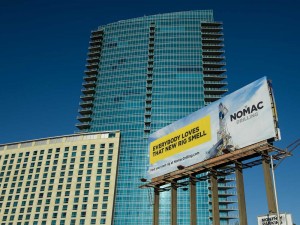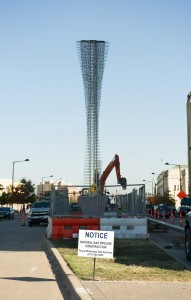Three basic types of gas pipelines make up the maze that runs below Fort Worth. Gathering lines carry wet gas, which still contains water and a host of hydrocarbons, from the wellhead to compressor stations and gas processing plants. The water and other substances are then removed, and the “dry” gas is transferred to transmission lines. Those are generally large interstate lines that carry refined natural gas to its destination. Much smaller, low-pressure delivery lines take gas to homes, factories, and other customers. Delivery lines are regulated by state and local ordinances. Transmission lines are regulated federally.

Gathering lines are the most dangerous of the three because they carry the most corrosive form of gas and other hydrocarbons under high pressure. Most of the gas in gathering lines is also unodorized, so leaks can go on for some time before they are detected — though by now most people in Fort Worth are familiar with the acrid smell and burning sensation in the nostrils produced by escaping unprocessed natural gas.
Gas companies say that odorizing the gas before it’s processed — as is done for the gas used in homes — is expensive and gives them just one more substance to remove before the gas can be put into a transmission line. Others in the business say that even if you odorize wet gas, the petroleum in the product absorbs the odorant, making it a pointless exercise.
Because gathering lines rarely cross state borders, they are not regulated federally. In Texas there is little real regulation.
Asked how Texas regulates such lines, Ramona Nye, spokeswoman for the Texas Railroad Commission, responded with an e-mail. She wrote that pipeline companies are required to obtain state permits that include information on the pipeline’s general route, its diameter, the commodity to be transported, the pipeline operator’s name, and what county or counties it goes through. Commission rules also require that transmission and gathering pipelines be installed at a depth of 36 inches.
Nye added an official disclaimer that the commission’s data on gas and oil pipelines — found on the Commission’s website — “are NOT intended to be used as an authoritative public record for any geographic location.” Which means, in effect, that there are no authoritative public records for pipeline location.
The 811 Call Before You Dig campaign is supposed to be the most accurate pipeline and utility line reference because the operators contact pipeline companies directly. The companies send workers to the property where digging is planned, to physically mark the lines. But as was shown in the Cleburne explosion, even the companies don’t always know where their pipelines are.

The Railroad Commission also requires that gas pipeline companies meet in person every 15 months with “fire, police, and other appropriate public emergency response officials,” to identify the types of gas pipeline emergencies, acquaint the officials with the pipeline operator’s ability to respond to emergencies, and plan how everyone can provide mutual assistance “to minimize hazards to life or property,” according to Nye’s e-mail.
Ortiz, the emergency management coordinator, said that meeting separately with each company every 15 months “would just be impossible. But we do have a couple of meetings a year with the pipeline groups.” At those sessions, representatives from pipeline groups discuss safety and provide updates on pipeline matters.
Is that enough, coupled with information on the location of 15 to 20 percent of the total gas lines, to help first responders know which way to have people evacuate in the case of a large pipeline leak?
“We’ve got plans in place to handle typical emergencies,” said Ortiz. “But if we are going to speculate on a catastrophic event, that’s difficult to answer. In general, we get alerted to a problem, go to the scene, collect information, determine the best course of action, and if we decide to evacuate, we do it expeditiously and very carefully.”
Sometimes, he said, you simply look at what evacuation routes are available and which way the wind is blowing.
But he admits that the reality is that the city and county have a finite number of law enforcement officers and firefighters and that citizens themselves must take some responsibility.
“Look, we do whatever we can to limit hazards to our communities,” he said. “But emergencies will occur, so people have to know how to protect themselves to some extent.”
The public needs to know what it means when sirens go off, for instance, he said, adding that they’re tested every Wednesday at 1 p.m. He said the public should be aware that there is a free service where people can get text messages or e-mail regarding emergency situations.
“They can sign up for that at Nixle.com,” he said. And the city will soon be offering a new service from a company called Deaf Link. “It’s called the Accessible Hazard Alerting System, AHAS, which is a new service that will allow deaf or blind citizens to register and receive an emergency alert to their smart phones or e-mail accounts via audio or American Sign Language video.” The service, currently being tested, should be ready in the next few weeks.
Ortiz also said that people have to move cautiously when digging holes. “Call 811 before you dig,” he said. “Have someone come out and mark the exact location of their lines.”
********












Great article.
I can only imagine the potential disasters awaiting the poor working guys who have to do the dirty, dangerous job of construction digging when Fort Worth’s pipeline documentation is so miserably bad.
Meanwhile, the demagogues who run Fort Worth continue to function as ‘two dollar whores’ for any and all business ventures, especially energy industry business, that wave money under a Cowtown politician’s nose.
About the pipeline explosion in Cleburne:
TRRC Williams stated they receive 1. 8,000,000 dig request per year and only 1 percent results in a nick of the pipeline. That is 18,000!
http://www.wfaa.com/news/local/Oil-well-explodes-in-Hood-County-95801134.html
About the pipeline explosion in Cleburne:
TRRC Williams stated they receive 1. 8,000,000 dig request per year and only 1 percent results in a nick of the pipeline. That is 18,000!
www@wfaa@com/news/local/Oil-well-explodes-in-Hood-County-95801134.html
About the pipeline explosion in Cleburne:
TRRC Williams stated they receive 1. 8,000,000 dig request per year and only 1 percent results in a nick of the pipeline. That is 18,000!
www@wfaa@com/news/local/Oil-well-explodes-in-Hood-County-95801134@html
About the pipeline explosion in Cleburne:
TRRC Williams stated they receive 1. 8,000,000 dig request per year and only 1 percent results in a nick of the pipeline. That is 18,000!
www@wfaa@com/
news/local/
Oil-well-explodes-in-Hood-County-95801134@html
About the pipeline explosion in Cleburne:
TRRC Williams stated they receive 1. 8,000,000 dig request per year and only 1 percent results in a nick of the pipeline. That is 18,000!
Your mobile app is buggy,sorry about dup post